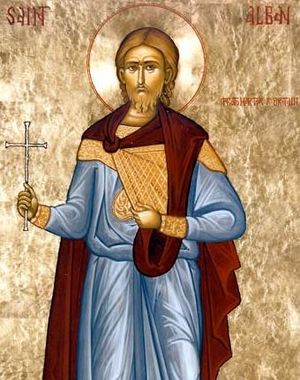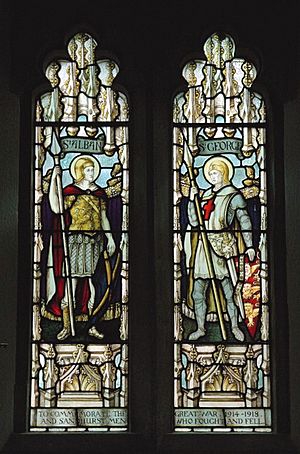Saint Alban facts for kids
Quick facts for kids SaintAlban |
|
|---|---|
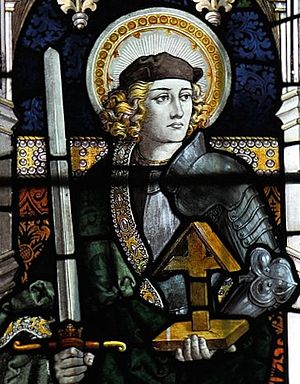 |
|
| Martyr | |
| Born | unknown Verulamium |
| Died | disputed: 22 June 209, c. 251 or 304 Holywell Hill (formerly Holmhurst Hill), St Albans |
| Venerated in | Roman Catholic Church Anglican Communion Eastern Orthodox Church |
| Major shrine | Cathedral and Abbey Church of St Alban |
| Feast | 22 June (General Roman Calendar of 1960 and Anglican Communion) 20 June (Current Roman Calendar) |
| Attributes | Soldier with a very large cross and a sword |
| Patronage | converts, refugees, torture victims |
Saint Alban (/ˈɔːlbən, ˈæl-/; Latin: Albanus) is venerated as the first-recorded British Christian martyr, for which reason he is considered to be the British protomartyr. Along with fellow Saints Julius and Aaron, Alban is one of three named martyrs recorded at an early date from Roman Britain ("Amphibalus" was the name given much later to the priest he was said to have been protecting). He is traditionally believed to have been beheaded in Verulamium (modern St Albans) sometime during the 3rd or 4th century, and his cult has been celebrated there since ancient times.
Contents
Hagiography
Alban lived in Roman Britain, but little is known about his religious affiliations, socioeconomic status, or citizenship. According to the most elaborate version of the tale found in Bede's Ecclesiastical History of the English People, in the 3rd or 4th century (see dating controversy below), Christians began to suffer "cruel persecution", and Alban was living in Verulamium. However, Gildas says he crossed the Thames before his martyrdom, so some authors place his residence and martyrdom in or near London. Both agree that Alban met a Christian priest fleeing from persecutors and sheltered him in his house for a number of days. The priest, who later came to be called Amphibalus, meaning "cloak" in Latin, prayed and "kept watch" day and night, and Alban was so impressed with the priest's faith and piety that he found himself emulating him and soon converted to Christianity. Eventually, it came to the ears of an unnamed "impious prince" that Alban was sheltering the priest. The prince gave orders for Roman soldiers to make a strict search of Alban's house. As they came to seize the priest, Alban put on the priest's cloak and clothing and presented himself to the soldiers in place of his guest.
Alban was brought before a judge, who just then happened to be standing at the altar, offering sacrifices to "devils" (Bede's reference to pagan gods). When the judge heard that Alban had offered himself up in place of the priest, he became enraged that Alban would shelter a person who "despised and blasphemed the gods," and, as Alban had given himself up in the Christian's place, Alban was sentenced to endure all the punishments that were to be inflicted upon the priest, unless he would comply with the pagan rites of their religion. Alban refused. The enraged judge ordered Alban to be scourged, thinking that a whipping would shake the constancy of his heart, but Alban bore these torments patiently and joyfully. When the judge realized that the tortures would not shake his faith, he gave orders for Alban to be beheaded.
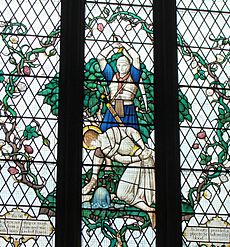
Alban was led to execution, and he presently came to a fast-flowing river that could not be crossed (believed to be the River Ver). There was a bridge, but a mob of curious townspeople who wished to watch the execution had so clogged the bridge that the execution party could not cross. Filled with an ardent desire to arrive quickly at martyrdom, Alban raised his eyes to heaven, and the river dried up, allowing Alban and his captors to cross over on dry land. The astonished executioner cast down his sword and fell at Alban's feet, moved by divine inspiration and praying that he might either suffer with Alban or be executed for him.
The other executioners hesitated to pick up his sword, and meanwhile, Alban and they went about 500 paces to a gently sloping hill, completely covered with all kinds of wild flowers, and overlooking a beautiful plain. (Bede observes that it was a fittingly beautiful place to be enriched and sanctified by a martyr's blood.)
When Alban reached the summit of the hill, he began to thirst and prayed God would give him water. A spring immediately sprang up at his feet. It was there that his head was struck off, as well as the head of the first Roman soldier who was miraculously converted and refused to execute him. However, immediately after delivering the fatal stroke, the eyes of the second executioner popped out of his head and dropped to the ground, along with Alban's head, so that this second executioner could not rejoice over Alban's death.
In later legends, Alban's head rolled downhill after his execution, and a well sprang up where it stopped. Upon hearing of the miracles, the astonished judge ordered further persecutions to cease, and he began to honour the saint's death.
St Albans Cathedral now stands near the believed site of his execution, and a well is at the bottom of the hill, Holywell Hill.
Disputed topics
Dating
The date of Alban's execution has never been firmly established. Original sources and modern historians indicate a range of dates between 209 and 313.
The Anglo-Saxon Chronicle lists the year 283, but Bede places it in 305, "when the cruel Emperors first published their edicts against the Christians." In other words, it was sometime after the publication of the edicts by Eastern Roman Emperor Diocletian in 303 and before the proclamation of toleration in the Edict of Milan by co-ruling Roman Emperors Constantine I and Licinius, in 313. Bede was probably following Gildas.
Location
While it is certain that the cult devoted to Saint Alban was established in Verulamium, and his martyrdom was also alleged to have taken place there, the sources are unclear about where he was actually executed. Neither Victricius's De Laude Sanctorum nor the Passio Albani mentions where he was martyred other than that it was in Britain. In the Vita Germani, Germanus visits Alban's tomb and touches droplets of his blood still on the ground, but the text does not name the location of the tomb. It is not until Gildas that Alban was connected with Verulamium.
Historicity
Little is known about the real Alban (estimated to have died c. 209 – 305 AD, depending on interpretations), as there are no contemporaneous accounts of his martyrdom and the major sources on his life were written hundreds of years after his death, containing wondrous embellishments, which may or may not refer to real events.
Saint Alban was long regarded as a genuine martyr saint, the protomartyr of Britain. More recently, however, some researchers have taken a more sceptical view about his historicity. In the view of Robin Lane Fox, not only is St Alban's date disputable but so is his very existence.
Cult
The hilltop located outside Verulamium eventually became the centre of the cult devoted to Alban. It has been claimed (but doubted by some) that a memoria over the execution point and holding the remains of St Alban may have existed at the site from c. 300, possibly earlier. There was certainly a cult centre of St Alban at Verulamium by the time of Bede c. 731, and the mention in Gildas strongly suggests that it was already in existence by the early sixth century. However, when and how the cult of Saint Alban originated is the subject of some debate: there is little textual or archaeological evidence that a cult of Saint Alban existed before Germanus of Auxerre visited the site in 429. In fact, one version of the Passio Albani says that Germanus did not know the name or story of Saint Alban before visiting the site, and Alban appeared to him in a dream to reveal his identity and martyrdom story. That can be interpreted as suggesting (see above: The Disputed Historicity) that the cult of Saint Alban did not exist before the arrival of Germanus. Germanus is said to have taken away dust from the site, which was still marked with Alban's blood. The cult and veneration of saints was still in its infancy at this time, and it has been suggested that Germanus had a hand in creating and promoting the cult of Saint Alban.

Gildas writing probably in the second quarter of the fifth century calls Saint Alban Verolamiensis, 'of Verulamium' in a passage that refers to the "graves and places where they suffered" of the early British martyrs. This suggests there was at least a shrine but quite possibly a church to him at Verulamium by then. Certainly, Bede (c. 720) mentions a church there, dedicated to him. Offa of Mercia established a Benedictine Abbey and monastery at the site c. 793, but the abbey was probably sacked and destroyed by the Danes c. 890. It was rebuilt by the Normans, with construction beginning in 1077. By the High Middle Ages, St Albans ranked as the premier abbey in England. The abbey church now serves as the cathedral of the Diocese of St Albans, established in 1877.
In a chapel east of the crossing and high altar are remains of the 14th-century marble shrine of St Alban. In June 2002 a scapula (shoulder blade), believed to be a relic of St Alban, was presented to St Albans Cathedral and placed inside the saint's restored 13th-century shrine. The bone was given by the Church of St Pantaleon in Cologne, Germany News. St Pantaleon's, like St Albans Cathedral a former Benedictine abbey church that had a shrine dedicated to St Alban, has possessed remains believed to be those of St Alban since the 10th century. It is entirely possible that further relics were acquired by the church in the 16th century at the time of the Dissolution of the Monasteries in England, when many such relics were smuggled abroad to prevent their destruction. St Albans Abbey was dissolved in 1539.
The largest relic of St Alban in England is the thigh of the protomartyr preserved at St Michael's Benedictine Abbey, Farnborough, Hampshire, which was transferred from the St Pantaleon's reliquary in the 1950s.
On the Continent
There has also been an extensive cult of Saint Alban on the Continent from an early date such as in Mainz, Cologne and Basel on the Rhine as well as a number of other localities in Switzerland and Italy and a notable concentration in the French Alpine regions and the Rhone Valley. Sometimes, the 'Saint Alban' concerned is regarded as a separate figure, other times, he is alternatively called Albinus (and often identified with 6th c. bishop, Saint Albinus of Angers), and at other times he is identified with the British martyr.
Saint Pantaleon's Church, Cologne holds relics said to be those of the British martyr Alban (as noted above). In fact, although identified with the British martyr, he was locally known as Albinus. His relics were said to have been brought from Rome by Empress Theophanu and placed in St Pantaleon's church in about 984: the relics were miraculously saved from destruction in an accident on the way at a place that a later version of 1502, was identified as Silenen, Switzerland. The original record was in a 12th-century manuscript that alleged that the relics were actually those of the British martyr, having been delivered to Ravenna by Germanus himself and taken from there to Rome. Another church at Cologne is known to have been dedicated to the British Alban from the 12th century.
The Saint Alban of Basel is recorded in the Berne recension of the Martyrologium Hieronymianum of circa 800: "Basilea civitate sancti Albani martyris", where he would appear to be an independent local figure, being celebrated on 24 August but later identified with the Saint Alban of Mainz.
St Alban of Mainz is recorded from 756. He was regarded as a separate figure in sources from Raban Maur's early 9th century martyrology, including a 10th-century Life by Gozwin of 1060–2 However, Hippolyte Delehaye suggested that he very probably represents, in origin, a localised version of the British martyr since his feast date was recorded as June 21 in the Martyrologium Hieronymianum (just a day before that of the British one, who actually appears on the 21st and 22nd in early recensions).
The story in Raban Maur associates Alban of Mainz with a martyred bishop, Aureus of Mainz and two other martyrs, Ursus and Theonestus the latter of whom is said to have originated on the Greek island of Naxos, together with Alban. A Saint Alban of Burano (near Altino, Italy), meanwhile was associated with one Domenicus in a legendary tale reminiscent of one told about Dionysus.
Veneration
Alban is remembered in the Church of England with a Lesser Festival on 22 June and he continues to be venerated in the Anglican, Roman Catholic, and Eastern Orthodox Communions. The Fellowship of Saint Alban and Saint Sergius is also named in part after Alban.
Every year, during the weekend closest to his feast day, St Albans Cathedral hosts the "Alban Pilgrimage", with huge puppets re-enacting the events of Alban's martyrdom around the city of St Albans.
Besides his abbey, churches in England dedicated to Saint Alban include the former St Alban, Wood Street in the City of London, St Alban's Church at Holborn in central London, ones in the London suburbs of Teddington, Croydon, Cheam and Ilford, one in Westcliff-on-Sea in Essex, others in Hull and Withernwick in the East Riding of Yorkshire, one in Swaythling, Southampton, one in Northampton, one in a Norwich suburb, one in Bristol, one in Tattenhall, Cheshire and another in Macclesfield, Cheshire. There is also St Alban's, West Leigh near Havant in Hampshire, and the St Alban the Martyr Parish Church of Highgate, Birmingham (including Ark St Alban's Academy). and St Alban the Martyr Church, Cowley, Oxford. Finally, a church is dedicated to Saint Alban at Earsdon Village, Northumberland, which is the nearest one to Bede's Holy Island. There is also a St Albans parish and church in Splott, Cardiff.
St Alban is the Patron Saint of the Liberal Catholic Church worldwide.
Outside Britain
Churches, festivals, and places dedicated to Saint Alban outside Britain include the following:
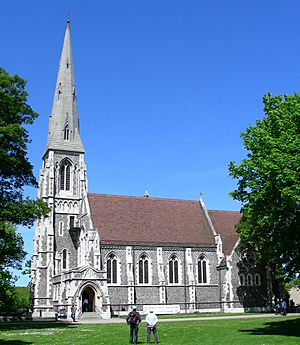
Australia
- Cathedral Church of St Alban the Martyr in Griffith, New South Wales
- Anglican Church of St Alban in Muswellbrook, New South Wales, Australia
- Anglican Church of St Alban the Martyr in Kalangadoo, South Australia
- Multicultural Bible Ministry (MBM) St Albans Anglican Church in Rooty Hill, New South Wales
- Anglican Church of St Alban the Martyr in St Albans, New South Wales
- Anglican Church of St Alban in Marradong, Western Australia
- St Alban's Anglican Church in Boggabilla, New South Wales
- St Alban's Anglican Church in Exeter, New South Wales
- St Alban's Anglican Church in Five Dock, New South Wales
- St Alban's Anglican Church in Lindfield, New South Wales
- St Alban's Anglican Church in Leura, New South Wales
- St Alban's Anglican Chapel at The Southport School, Southport, Queensland
- Liberal Catholic Church of St Alban in Spring Hill, Brisbane, Queensland
- Liberal Catholic Church of St Francis and St Alban in Gordon, Sydney, New South Wales
Places
- St Albans, Victoria is a suburb of Melbourne
- St Albans, New South Wales
- Victoria University, Melbourne has St. Albans Campus
Canada
Alberta
- St. Albans Anglican, Brooks
British Columbia
- St. Albans Anglican, Ashcroft
- St. Alban Anglican Church, Burnaby
- St. Alban Anglican Church, Richmond
Manitoba
- St. Alban's Anglican Church in Manitoba, which was built in 1892
New Brunswick
- St. Alban's Church, the Anglican Parish of New Bandon, Diocese of Fredericton
- St Alban's Anglican Church, Salmon Beach
Newfoundland
- St Alban's Anglican Church, Grand Falls-Windsor
- Saint Alban the Martyr Anglican Church, Gooseberry Cove
- Saint Alban's Anglican Church, New-Wes-Valley
Nova Scotia
- St. Alban's Church, Sydney
Ontario
- St. Alban's Cathedral (Kenora)
- St Alban's Anglican Church in Ottawa
- Cathedral of St. Alban the Martyr in Toronto (1883–1936) – ceased as Cathedral in 1936 and sold for use as a chapel for Royal St. George's College
- St Albans Anglican Church, Grand Valley, Ontario
- St. Alban the Martyr Anglican Church, Georgetown, Ontario
- St. Alban's Anglican Church, Stella, Ontario on Amherst Island
- St. Alban's Anglican Church, Acton, Ontario
- St. Alban's Anglican Church, Lincoln, Ontario
- St. Alban's Anglican Church, Restoule
- St. Alban's Anglican Church, Capreol
- St. Alban's Anglican Church, Mattawa, Ontario
- Saint Alban the Martyr Anglican Church, Greater Napanee
Prince Edward Island
- St. Alban's Church, Anglican, Souris, Prince Edward Island
Saskatchewan
- St. Alban's Cathedral (Prince Albert)
Quebec
- Fabrique de la Paroisse de Saint-Alban (Le), Saint-Alban
Places
- St. Alban's, Newfoundland and Labrador The name was changed from Ship Cove to St. Alban's in 1915.
- Saint-Alban, Quebec
- St. Alban's Square, Toronto, Ontario
Denmark
St Alban's Church in Copenhagen, Denmark, which is the city's only Anglican church. It was built to the design of Sir Arthur Blomfield and consecrated in 1887. The connection with Denmark goes back to the Middle Ages where a church dedicated to Saint Alban was built in Odense. Supposedly, the relics of the saint had been brought here, maybe as early as the ninth century. It was in that church that King Canute IV of Denmark (Saint Canute) was murdered in 1086. The original church no longer exists, but the Roman Catholic parish church of Odense, St Alban's Church, was consecrated in 1908.
France
- St Alban's Anglican, Strasbourg, France
- Church Saint Alban, Elven, France
Places
- Saint-Alban-Auriolles inhabitants are called Saint Albanians
- Saint-Alban, Côtes-d'Armor inhabitants are called Albanais
- Saint-Alban, Haute-Garonne
- Saint-Alban-sur-Limagnole pronounced Sent Aoubo
- Saint-Alban-de-Montbel
- Saint-Alban-des-Villards
- Saint-Alban-Leysse
- Saint-Alban-de-Roche
- Saint-Alban-d'Hurtières
Germany
- Saint Pantaleon's Church, Cologne, a former Benedictine abbey church, has held a shrine to St Alban since the 10th century. Some relics are believed to have ended up in the church in order keep them safe from destruction after the Dissolution of the Monasteries by King Henry VIII of England in the 16th century. In 2002, a collar bone, one of the relics in the shrine, was moved to St Albans Cathedral in England, and placed in the shrine to Saint Alban there.
- Alt St. Alban in Cologne dates back to 1172 however, it was redesigned in 1668–72 by architect Arnold Gülich. The bell tower dates from 1494, and the facade from 1896. It was heavily bombed in WWII and in 1954, Josef Frings released Alt St. Alban so that the city could incorporate it into the construction of the Gürzenich. The Neu St. Alban was built on a new plot of land using materials from Oper Köln, which was demolished in 1958.
- Wehrkirche St. Alban und St. Wendelin, Morsbach (Künzelsau)
- Benediktinerinnen von St. Alban, Dießen am Ammersee
- Saint Alban's Abbey, Mainz Kath. Kirche St. Alban, Mainz
- Katholische Kirche St. Alban, Bad Krozingen
- Katholische Kirche St. Alban, Heilbronn
- St. Alban Kirche, Wallerstein
- Wallfahrtskirche St. Alban, Aitrang
- Buchloe
- Walkertshofen
- St. Albani, Göttingen
Ghana
- St. Alban Anglican Church, Tema, Ghana
Grenada
- St. Alban's Anglican Church, Mt Moritz
India
- St. Albans CSI Anglican Church, Kottayam
Japan
- St. Alban Church, Tochigi
- Saint Alban's Anglican-Episcopal Church, Minato City
Kenya
- ACK St. Alban's Church in Molo, Kenya
- ACK St. Alban Parish Makadara in Nairobi, Kenya
Malaysia
- St. Alban Anglican Church, Sarawak
New Zealand
- St. Alban's Anglican Church, Lower Hutt
- St. Albans Baptist Church, Christchurch
- St. Alban's Uniting Church, Christchurch
- St. Alban's Anglican Church, Appleby
- St. Alban's Church, Porirua
- St. Alban's Church, Waingaro
- St. Alban the Martyr Anglican Church, Balmoral
- St. Albans Presbyterian Church, Palmerston North
- Chartwell Cooperating Church of St. Alban's, Hamilton
Places
- St Albans is a suburb of Christchurch
Nigeria
- St Alban's Anglican Church, Degema
Philippines
- Saint Alban Episcopal Church, Episcopal Diocese of North Central Philippines, Mankayan
Solomon Islands
- St Alban Church, Honiara
South Africa
- St Albans Cathedral, Pretoria
- St Alban's Anglican Church, Kimberley
- St. Alban's Church, East London
- St Albans Anglican Church, Benoni
- St Albans Anglican Church, Johannesburg
- St Albans Liberal Catholic Church, Johannesburg
- St. Alban the Martyr Anglican Cathedral, Pretoria
Places
- St. Alban's College
Switzerland
St.-Alban-Kirche (Basel) (Serbisch-Orthodoxe-Kirche) with sacral predecessors dating back to 1083
United States
St. Albans is the name of a community in the borough of Queens in New York City. In 1899, a year after Queens became part of New York City, the new post office for the 600 residents was named St. Albans, after St Albans in Hertfordshire, England, which itself was named after Saint Alban. The name had been in use for the area since at least 1894 for the name of the school district, and the LIRR station was named St. Albans when it opened in 1898. A 1909 map also shows a St Albans Avenue and a St Albans Place in the area.
The parish church of St Alban's Episcopal Church in Washington, D.C., was erected on Mount Saint Alban in 1854 using a bequest from a young woman, Phoebe Nourse, who earned the money sewing. St Alban's went on to found five mission churches in Washington, four of which still maintain active congregations of their own. Washington National Cathedral, a cathedral of the Episcopal Church in Washington D.C., is located next to the parish church, which preceded the laying of the Cathedral's cornerstone by 53 years. The St Albans School for Boys, which is affiliated with and was established in 1909 soon after the construction of the Cathedral began, is also named for the saint.
In 1972, a chapel named after St. Alban was erected and later consecrated in the Sabino Catchment area of Tucson, Arizona. The chapel and the congregation later became St. Alban's Church and Parish. It was in this church that the second Anglican female priest, and first female priest in Arizona, was ordained.
In 1928, St. Alban's Chapel, an Episcopalian church, was established on the campus of Louisiana State University in Baton Rouge, Louisiana.
After undergoing several name changes, St. Albans is the name of a community West of Charleston, West Virginia, the capital of the state.
Incomplete List...
- St Alban's Episcopal Church:
– Hoover, Alabama – Stuttgart, Arkansas – Catalina Foothills, Arizona – Wickenburg, Arizona – Tucson, Arizona – Yucaipa, California – Los Angeles, California – El Cajon, California – Arcata, California – Albany, California – Windsor, Colorado – Hartford, Connecticut – Wilmington, Delaware – St. Pete Beach, Florida – Auburndale, Florida – Andrews, Florida – Augusta, Georgia – Monroe, Georgia – Chicago, Illinois – Indianapolis, Indiana – Fort Wayne, Indiana – Spirit Lake, Iowa – Davenport, Iowa – Monroe, Louisiana – Cape Elizabeth, Maine – Glen Burnie, Maryland – Salisbury, Maryland – Edina, Minnesota – Minneapolis, Minnesota – Bay City, Michigan – Manistique, Michigan – Warren County, Mississippi – Cape Elizabeth, Maine – New Brunswick, New Jersey – Oakland, New Jersey – McCook, Nebraska – Syracuse, New York – Staten Island, New York – Brooklyn, New York – Littleton, North Carolina – Hickory, North Carolina – Davidson, North Carolina – Albany, Oregon – Deschutes County, Oregon – Tillamook, Oregon – Newtown Square, Pennsylvania – Whitfield, Pennsylvania – Middle Valley, Tennessee – El Paso, Texas – Austin, Texas – Arlington, Texas – Hubbard, Texas – Houston, Texas – Waco, Texas – Travis County, Texas – Annandale, Virginia – two in Washington, D.C. – Edmonds, Washington – Washakie County, Wyoming – Superior, Wisconsin – Sussex, Wisconsin – Spooner, Wisconsin – Maricopa County, Arizona – Peoria, Arizona – Los Banos, California – Harford County, Maryland – Arlington, Texas – Tacoma, Washington
- St Alban's Anglican Catholic, Richmond, Virginia
- St Albans Church of God in St. Paul Minnesota
- St. Albans Chapel, Baton Rouge, Louisiana
- Church of St Alban, Philadelphia, PA
- St. Albans Open Air Chapel in Albany County, Wyoming
- St. Alban's Catholic Church in Rochester, NY
Places
- St. Albans (city), Vermont
- St. Albans (town), Vermont
- St. Albans School (Washington, D.C.) One of the top US boarding schools.
See also
 In Spanish: Albano de Verulamium para niños
In Spanish: Albano de Verulamium para niños
- Catholic Church in England
- List of early Christian saints
- List of protomartyrs
- Saint Alban's Cross
- St. Alban's Church (disambiguation)
- St. Alban's Episcopal Church (disambiguation)


